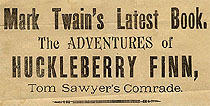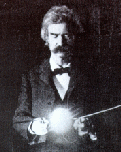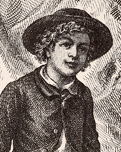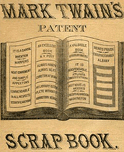
"before the afternoon was done, they had all managed to
enjoy the sweet glory of spreading the fact
that pretty soon the town would 'hear something.'" --
Adventures of Tom Sawyer Chapter 13

|
After reading the novel in manuscript, William Dean Howells suggested to MT that he could "deliberately advertise it by Atlantic publication" before bringing it out as a book. MT replied that he could not afford to sell the story to the Atlantic for what the magazine Howells edited would be able to pay, but he did not hesitate to ask his friend to review the book in the Atlantic as part of the sales campaign; Howells himself thought of the review he wrote at least in part as designed "to start the sheep jumping in the right places" (see Reviews). Moncure Conway, whom MT had commissioned as his agent to
secure the novel's publication in England, reviewed the
British edition in the London Examiner the day the
book appeared there (see Reviews). Conway was also a foreign
correspondent for the Cincinnati Commercial. In his
"London Letter" published in the Commercial on 26
June 1876 he wrote a long notice of Tom Sawyer that
repeated many of the things he said in the Examiner
review, but also included five long excerpts from the
story. Many American papers reprinted part or all of
Conway's "Letter." The excerpted passages from Tom
Sawyer -- the introduction of Huck, Injun Joe's Cup,
the satire on sentimental eloquence, the pinchbug in
church, and, at greatest length, the whitewashing scene --
were reprinted in such papers as the Philadelphia Sunday
Republic, the New York Evening Post, the Boston
Transcript, the Portland Transcript, the
Springfield Republican and the San Francisco
Call. Conway's entire "Letter," including the
quotations, was reprinted in such papers as the St. Louis
Globe Democrat, the Chicago Tribune and the
Hartford Times. Because the passages Conway chose
were so widely reprinted, his letter functioned almost as a
pre-publication preview of the novel. Because the American
edition did not appear until almost half a year later, his
comments on the novel and selections from it were for a
long time the only way most Americans "knew" Tom
Sawyer. Bliss prepared his own account of the
novel for the prospectus, where he also printed severely
edited passages from four favorable reviews, including
Howells'. As you can see, although MT apparently accepted
Howells' suggestion about treating Tom Sawyer as a
"boys' book," Bliss promoted it instead as a book for adult
readers. According to Hamlin Hill, sometime after the publication
of Tom Sawyer, when subscription sales had stalled,
Bliss arranged a circular and sent it to prospective
mail-order customers. There is no copy of this circular in
the Barrett Collection, but Hill says it was a single
sheet, double-sided, with the novel's first page on the
front and his own "advertisement" for the novel on the
back, so it is possible to get a sense of how the circular
looked: 
If promoting the book this way improved sales at all, the process was a slow one. As mentioned in the section on Composition, Revision and Piracy, sales of the authorized edition of Tom Sawyer started growing when Huck Finn was published in 1885 -- presumably because of Tom's appearance in the novel, and also because all the ads for Huck prominently mentioned Tom. |


